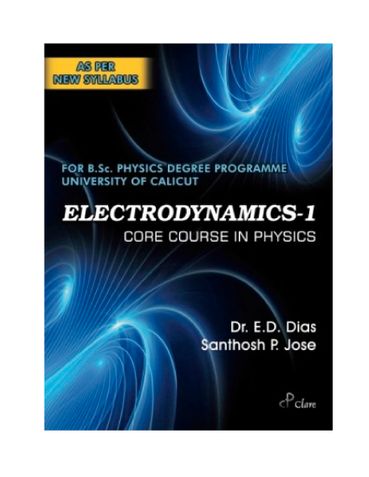You can access the distribution details by navigating to My pre-printed books > Distribution
Description
The very purpose of the book is to bridge the gap between the text books of the higher secondary level and the advanced level books on Electrodynamics. This book covers the topics required for a first course in Electrodynamics. The solutions of all the exercises are provided in the book itself. The book focuses on basic concepts of electromagnetic theory with stress given both on physical concepts and mathematical treatment. The language used in the book is quite lucid. A large number of questions are given at the end of every chapter for ascertaining the clarity of concepts.
<strong>Contents<strong>
CHAPTER 1 Page (1-50)
<strong>VECTOR CALCULUS<strong>
1.1 Introduction
1.2 Scalar Function
1.3 Vector Function
1.4 Vector Components
1.5 Product of Two Vectors
1.5.1 Dot Product or Scalar Product or Inner Product
1.5.2 Cross Product or Vector Product
1.6 Triple Products
1.6.1 Scalar Triple Products
1.6.2 Vector Triple Products
1.7 CALCULUS
1.7.1 Differentiation
1.7.2 Integration
1.7.3 Integration by parts
1.8 Three Important Integrals
(1) Scalar Line Integral of Vector Functions
(2) Scalar Surface Integral of Vector Functions
(3) Volume Integral of Vector Functions
1.9 Gradient
1.10 Divergence
1.11 Curl (or Circulation or Rotation)
1.12 Three Fundamental Theorems in Vector Calculus
(1) Gauss’s Theorem or Gauss Divergence Theorem or Divergence Theorem
(2) Stokes’ Theorem
(3) Theorem for Gradient
1.13 Some Important Vector Identities
1.14 Orthogonal Co-ordinate Systems
1. Rectangular Cartesian Co-ordinate System
2. Spherical Polar Co-ordinate System
3. Cylindrical Co-ordinate System
1.15 Vector Transformation
1.16 Dirac Delta Function
1.17 Helmholtz’s Theorem
Answers of exercise
Questions
Solutions of the Exercise
CHAPTER 2 Page (51-114)
<strong>ELECTROSTATICS<strong>
2.1 Introduction
2.2 Coulomb’s Law
2.3 Unit of Electric Charge
2.4 Electrostatic Field
2.5 Superposition Principle of Electric Field
2.6 Electric Field due to Continuous Charge Distributions
(1) Field due to a Linear Charge Distribution
(2) Field due to Surface Charge Distribution
(3) Field due to Volume Charge Distribution
2.7 Electrostatic Field Lines and Flux
2.8 Properties of ELECTROSTATIC Field Vector
2.8.1 Gauss's Law in Electrostatics (Divergence of E)
2.8.2 Derivation of Coulomb's Law from Gauss's Law
2.8.3 Curl of Electrostatic Field (Concept of Potential for Electrostatic Field)
2.9 Electrostatic Potential Energy from Potential
2.10 Potential Energy of Charge Distribution
2.11 Electrostatic Energy in terms of E
2.12 Poisson's Equation and Laplace's Equation
2.13 Conductors
2.14 Applications of Gauss’s Law
2.14.1 Electric Field due to Charges on a Spherical Conductor
2.14.2 Field due to a Uniform Distribution of Charges on a Non-Conducting Sphere [or Uniform Spherical Charge Distribution]
2.14.3 Field due to a Charged Conducting Cylinder
2.14.4 Field just outside a Charged Conductor
2.14.5 Field due to a Plane Sheet of Charge
2.14.6 Field due to an Infinite Straight-Line of Charge
2.15 Force on Surface Charge of a Conductor - Electrostatic Pressure
2.16 Capacitors
2.16.1 Electric Field between the Plates of a Parallel Plate Capacitor
2.16.2 Capacity of a Parallel Plate Capacitor
2.16.3 Energy of a Charged Capacitor
Answers of exercise
Questions
Solutions of the exercise
CHAPTER 3 Page (115-164)
<strong>ELECTROSTATIC FIELD INSIDE MATTER<strong>
3.1 Dipole
3.1.1 A Dipole in an Electrostatic Field
3.1.2 Potential and Field due to a Dipole
3.1.2 Potential Energy of a Dipole
3.2 Polar and Non-polar Molecules
3.3 Molecules Placed in an Electric Field
3.4 Polarisation
3.5 Linear Dielectrics
3.5.1 Polarisability
3.5.2 Susceptibility
3.6 Polarisation of a Simple Spherical Atom
3.7 Three Electric Vectors
3.8 Electric Field due to a Polarised Object
3.8.1 Physical Interpretation of Bound Charges
3.9 Gauss’s Law inside Dielectrics
3.10 Energy in Dielectric System
3.10.1 Change in Energy on Inserting a Dielectric
3.11 Force on Dielectrics
3.11.1 Change in Energy when the Dielectric is Removed
(CELL NOT CONNECTED)
3.11.2 Change in Energy when the Dielectric is Removed
(WITH CELL CONNECTED)
3.11.3 Fringing Field – The Reason for the Attractive Force
3.11.4 Calculation of the Attractive Force
3.11.5 Verification of the Expression for the Force (With the cell connected)
3.12 Energy in terms of E and D
3.13 Relation between Susceptibility and Polarisability
3.13A Clausius–Mossotti Equation
3.14 Electrostatic Boundary Conditions at a Dielectric Interface
Answers of exercise
Questions
Solutions of Exercise
CHAPTER 4 Page (165-207)
<strong> MAGNETOSTATICS <strong>
4.1 Introduction
4.2 Magnetic Flux Density or Magnetic Induction
4.3 Lorentz Force Law
4.4 Current
4.5 Continuity Equation
4.6 Force on a Current Carrying Conductor
4.7 Torque on a Current Loop and the Magnetic Moment
4.8 Cyclotron
4.9 Cycloid Motion
4.10 Magnetic Effect of Electric Current
4.11 Magnetic field due to steady currents
4.11.1 Biot-Savart’s Law
4.11.2 Magnetic Induction due to a Straight Conductor
4.11.3 Field dye to a circular loop
4.12 Field due to a Circular Loop Force between Parallel Conducting Wires
4.13 Ampere’s Circuital Law (curl of B)
4.14 The Divergence of B
4.15 Applications of Ampere’s Law
(1) Field due to an Infinitely Long Conducting Wire
(2) Toroid
(3) Solenoid
4.16 Vector Potential
4.17 Comparison of Magnetostatics and Electrostatics
4.18 Comparison of Electric and Magnetic Dipolemoments
Answers of Exercise
Questions
Solutions of exercise
CHAPTER 5 Page (208-238)
<strong>MAGNETIC FIELD INSIDE MATTER<strong>
5.1 Introduction
5.2 Torque and Force on a Magnetic Dipole (or Current loop)
5.3 Magnetisation (Or Intensity of Magnetisation)
5.4 Ampere’s Law inside Magnetised Materials
5.5 Qualitative Idea about the Cause of Magnetism in Materials
5.6 Magnetic Hysteresis
5.7 Effect of Magnetic Field on Atomic Orbits
(Cause of Diamagnetism)
5.8 Magnetostatic Boundary Conditions
5.9 The Field due to a Magnetised Object
(Contribution from Bound Currents)
5.10 Auxiliary Field H
5.11 Magnetic Models
5.11.1 Magnetic Pole Model and the Hfield
5.11.2 Amperian Loop Model and the B-field
Answers of Exercise
Questions
Solution of Exercises
Appendix
Model Question Paper
Syllabus
About the Authors
Book Details
Ratings & Reviews

Currently there are no reviews available for this book.
Be the first one to write a review for the book Electrodynamics-1.
Other Books in Education & Language, Science & Technology
AIMSHREEM
BALDEV BHATIA
Students’ Academy, Raja Sharma
Sujatha A. Krishna Rao




